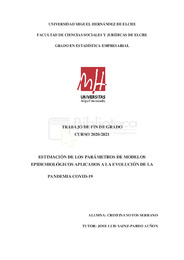Por favor, use este identificador para citar o enlazar este ítem:
https://hdl.handle.net/11000/26762Registro completo de metadatos
| Campo DC | Valor | Lengua/Idioma |
|---|---|---|
| dc.contributor.advisor | Sainz-Pardo Auñón, José Luis | - |
| dc.contributor.author | Sotos Serrano, Cristina | - |
| dc.contributor.other | Departamentos de la UMH::Estadística, Matemáticas e Informática | es_ES |
| dc.date.accessioned | 2022-05-02T12:11:27Z | - |
| dc.date.available | 2022-05-02T12:11:27Z | - |
| dc.date.created | 2021-06 | - |
| dc.identifier.uri | http://hdl.handle.net/11000/26762 | - |
| dc.description.abstract | En diciembre del 2019 se inició una pandemia mundial con origen en Wuhan (China), se trata de una enfermedad por coronavirus causada por el SARS-CoV-2. Fue rápidamente expandida por todo el mundo debido a su carácter infeccioso. Con el fin de frenar esta pandemia cada uno de los Estados afectados impusieron medidas epidemiológicas como un confinamiento territorial y poblacional, lo que conllevó a la paralización de algunos países dejando atrás una gran crisis económica. Para la predicción de la evolución de estas epidemias en las poblaciones existen diversos modelos matemáticos epidemiológicos basados en ecuaciones diferenciales, como son el SIR, SIS, SIRS, SEIS, SEIR, MSIR y MSEIR. Sin embargo, a pesar de no ser el modelo que mejor se adapte a la expansión del COVID-19, el modelo SIR es el que se lleva a cabo en el presente trabajo y el más utilizado tanto por su simplicidad como por ser uno de los primeros modelos en formularse, éste consiste en diferentes ecuaciones diferenciales que estudian la transmisión del virus dividiendo a la población en tres grupos, susceptibles, infectados y recuperados. En el presente trabajo se llevan a cabo cuatro escenarios diferentes con el objetivo de encontrar el modelo que mejor se ajuste a la evolución de la pandemia sufrida en el territorio español durante la primera oleada. Finalmente, ha sido un modelo SIR, establecido para las fechas correspondientes del 1 de enero al 19 de abril del 2020, el que mejor se ajusta a esta evolución y que mejores resultados nos ha proporcionado. | es_ES |
| dc.description.abstract | In December 2019, a global pandemic started with origin in Wuhan (China), it is a coronavirus disease caused by SARS-CoV-2. It was rapidly spread throughout the world due to its infectious nature. In order to curb this pandemic, each of the affected countries imposed epidemiological measures such as territorial and population confinement, which led to the paralysis of some countries, leaving behind a major economic crisis. For the prediction of the evolution of different epidemics in populations, there are several epidemiological mathematical models based on differential equations, such as SIR, SIS, SIRS, SEIS, SEIR, MSIR and MSEIR. However, in spite of not being the model best adapted to the expansion of COVID-19, the SIR model is the one used in the present work and the most widely used both for its simplicity and for being one of the first models to be formulated. It consists of different differential equations that study the transmission of the virus by dividing the population into three groups, susceptible, infected and recovered.In the present work, four different scenarios are carried out with the aim of finding the model that best fits the evolution of the pandemic suffered in the Spanish territory during the first wave. Finally, a SIR model, established for the dates corresponding to January 1 to April 19, 2020, has been the one that best fits this evolution and that has provided the best results. | es_ES |
| dc.format | application/pdf | es_ES |
| dc.format.extent | 107 | es_ES |
| dc.language.iso | spa | es_ES |
| dc.publisher | Universidad Miguel Hernández de Elche | es_ES |
| dc.rights | info:eu-repo/semantics/openAccess | es_ES |
| dc.rights | Attribution-NonCommercial-NoDerivatives 4.0 Internacional | * |
| dc.rights.uri | http://creativecommons.org/licenses/by-nc-nd/4.0/ | * |
| dc.subject | COVID-19 | es_ES |
| dc.subject | pandemia | es_ES |
| dc.subject | modelos epidemiológicos | es_ES |
| dc.subject.other | CDU::3 - Ciencias sociales::31 - Demografía. Sociología. Estadística::311 - Estadística | es_ES |
| dc.title | Estimación de los parámetros de modelos epidemiológicos aplicados a la evolución de la pandemia covid-19 | es_ES |
| dc.type | info:eu-repo/semantics/bachelorThesis | es_ES |

Ver/Abrir:
TFG- Sotos Serrano, Cristina.pdf
2,47 MB
Adobe PDF
Compartir:
 La licencia se describe como: Atribución-NonComercial-NoDerivada 4.0 Internacional.
La licencia se describe como: Atribución-NonComercial-NoDerivada 4.0 Internacional.
.png)